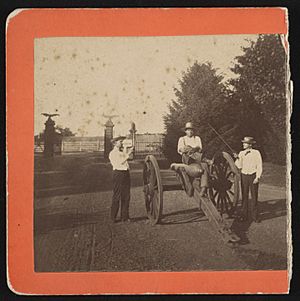Gettysburg Battlefield Memorial Association facts for kids

The Gettysburg Battlefield Memorial Association (GBMA) was a group formed to protect and remember the Gettysburg Battlefield. It was a very important organization during the "memorial association era" of the battlefield. The state of Pennsylvania officially recognized the GBMA on April 13, 1864. This happened after a lawyer named David McConaughy suggested creating a group to raise money for the battlefield. He thought they could sell memberships to do this.
McConaughy gave the GBMA land he had bought in 1863. The first leaders of the association were local officials. The GBMA raised money by selling shares, like a company. They also hired a superintendent to manage things. The association bought more land to add to McConaughy's original gifts. From 1878 to 1895, they even ran a wooden observation tower on East Cemetery Hill. This tower let visitors see the battlefield from above.
The GBMA usually only allowed memorials to be placed on specific, established lines. But they made a few exceptions. For example, they allowed a plaque in 1887 for General Armistead's farthest advance. They also approved the 1884 2nd Maryland Infantry monument on Culp's Hill. By 1880, many GBMA officers were members of the Grand Army of the Republic. This was a group for Union Civil War veterans. By the early 1880s, the GBMA was running out of money. By the 1890s, the roads they managed were in bad shape.
Contents
Dispute Over Monument Placement
After the state approved the GBMA, the association claimed it had the only right to decide where all monuments should go. This included monuments not on their own land. In July 1888, the GBMA said no to the 72nd Pennsylvania Infantry regiment. The regiment wanted to put a statue on their own land at The Angle. A state committee had already approved this location.
The 72nd Pennsylvania Regiment Case
On December 12, 1888, the GBMA had Captain John Reed of the 72nd Regiment arrested. They said he was trespassing. He had started building the foundation for the regiment's monument. In October 1889, a court case began: Gettysburg Battlefield Memorial Association v. Seventy-second Pennsylvania Regiment. The court heard arguments about where the regiment was during Pickett's Charge.
The Supreme Court of Pennsylvania decided in favor of the 72nd Regiment. Justice Sterrett said that the state of Pennsylvania "has the right to designate the position where any of her regiments specially distinguished themselves." This meant the state, not just the GBMA, could decide monument locations. On July 4, 1891, the monument was dedicated. Edward McPherson accepted the monument for the GBMA. But on August 25, the GBMA leaders suggested adding a sign. This sign would say the GBMA was "no responsibility for the location of the monument as now placed."
In 1888, the association planted trees in Zeigler's Grove. In 1889 and 1890, the GBMA first said no to John B. Bachelder's idea for the 1892 High Water Mark of the Rebellion Monument. But in 1891, they all agreed to it.
Trolley Line Conflict
In 1884, the GBMA allowed a steam train railroad, the Round Top Branch, to cross the battlefield. But in August 1891, they refused to let the Gettysburg Electric Railway build a trolley line on battlefield roads. The trolley company then bought rights to build on roads in Cumberland Township.
Legal Battle Over the Trolley
The GBMA tried to stop the trolley construction in Pennsylvania. But they lost their case. In August 1893, the state's Attorney General ruled against them. He said that private property owners had the right to build. He also noted that the trolley line was planned to help tourists see the battlefield. He believed it would cause "the least possible injury to its natural conditions."
The federal government then got involved. The Gettysburg Park Commission (GPC) was created on March 3, 1893. Its job was to figure out how much land the trolley would affect. John B. Bachelder, who used to be the GBMA's Superintendent of Tablets and Legends, became one of the three federal commissioners.
The federal government started buying GBMA land on June 7, 1893. This land would become the Gettysburg National Military Park in 1895. They bought small plots for monuments and a larger 1.2-acre lot from the GBMA. On June 16, 1893, Bachelder complained to the Secretary of War about the trolley building on private land.
The GBMA filed a federal lawsuit on April 7, 1894. They wanted to stop the trolley from using Hancock Avenue. The federal Attorney General also filed a similar case. But both lawsuits were dismissed on June 20, 1894. After this, new federal laws were passed. These laws allowed the War Department to pay off the GBMA's debts. On February 4, 1896, the War Department bought 124 GBMA land sections. This totaled about 522 acres.
The End of an Era
In 1894, a committee was formed to see if the GBMA's remaining property could be given to the U.S. government. The GBMA held its last meeting on May 22, 1895. By the time the GBMA finished its work, it had spent over $680,000. They had helped create 320 monuments and about 17 miles of roads. After 1895, the Gettysburg Battlefield commemorative era began. During this time, even more monuments and roads were added.
A monument honoring the GBMA's efforts was finished in 1908. In 1941, the GBMA's financial records were found in a church. In 1982, the meeting notes from the GBMA Board of Directors (1872–1895) were copied down. They were put into a computer system in 1997.

